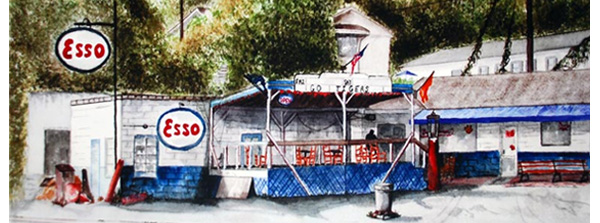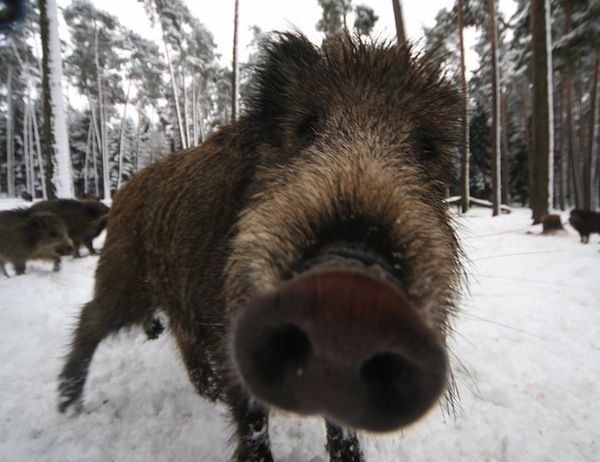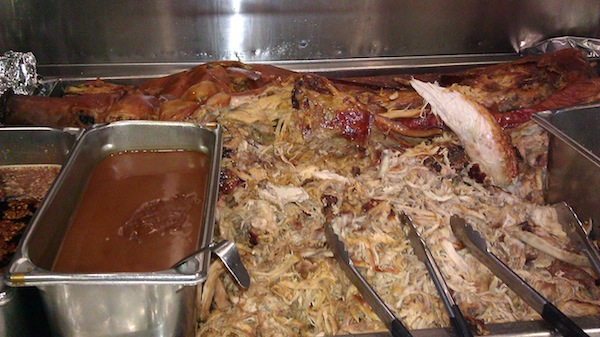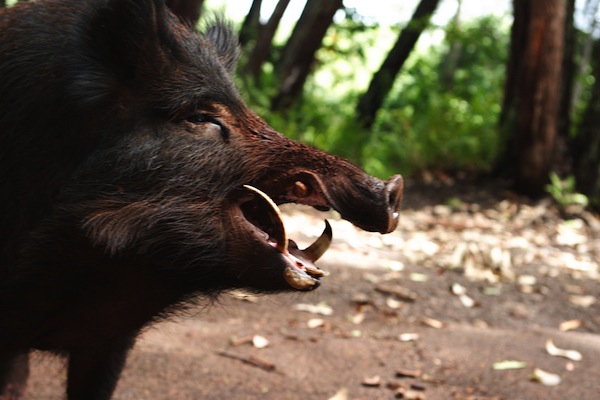Pig Whisperer for a Wedding Day (Best of “Hubris”)
“This certainly would not be my first pig-cooking, but pit-mastering for this particular couple demanded that I produce the best results possible. I wanted to honor my friends, of course, but there was also the added incentive that I would be serving some people whom I knew to be top notch barbecuers, and others who considered themselves seasoned judges of this southeastern US tradition, veritable Sommeliers of Sauce. (Jeff, himself, is no slouch as a pit-master, and Lesslie’s father Tom has whipped up many an excellent meal during football and baseball tailgate parties. I knew my results would be judged by people who ‘knew their ‘cue.’)”—Ted Balk
Dispatches from The Esso Club
By Ted Balk
CENTRAL South Carolina—(Weekly Hubris)—12/19/2016—It had been a while since an opportunity to spend quiet time sitting with a pig had presented itself. So, when Jeff asked, I quickly accepted, even though it meant missing my regular Saturday morning Yoga class.
The occasion was the celebration of the second birthday of Jeff and Lesslie’s son, and my good buddy, JB. They were going all out, as is their wont, with a party including four generations of family as well as 50 or so close friends. When possible, in this part of the southeastern US, the central focus for a big party of this sort is the cooking of a “whole hog.” Jeff was doing a hundred-pound pig (45 kg), which takes around twelve hours of close, if not constant, attention, and he needed help.
I got involved in the pig-sitting when Jeff realized that the day of JB’s party was also the day their newborn second son, Will, was to be christened and baptized. He may have thought his wife would understand his “having to stay with the pig,” but Lesslie was having none of that, and thus the call went out to me the day before the party.
As I said, I jumped at the opportunity. I would really have minimal responsibility. I just needed to keep an eye on things, and make sure the gas burners stayed lit and the cooking temperature remained in the proper range for the several hours the family was at the church for and luncheon following Will’s ritual anointing.
Everything went smoothly: the family came home, and I left and came back later to a wonderful celebration with a diverse crowd of friends varying in age from infancy to their upper 80s, which included four generations of JB’s and Will’s kinfolk. A fine time was had by all. The pig was devoured in its entirety, accompanied by a large quantity of beer, beans, mac-and-cheese and other fine comestibles. The numerous young among us ate and played to exhaustion, as did the older folks, with everyone finding the proper time to fade away, to sleep or go home.
All of this put me in mind of the time, four years earlier, when I was asked to be the pit master (that’s a technical term for the chief cook and bottle washer at a pig cooking) for a major barbecue for the reception following Jeff and Lesslie’s wedding.
This request comprised a singular honor for me. People round here can be pretty picky about things like weddings and receptions, so the level of trust in my cooking skills the invitation implied gladdened me. (Of course, I’m sure Jeff would have preferred to do the cooking himself but, again, Lesslie was having none of that, as Jeff would be otherwise occupied with getting married and such.)
I have known Lesslie and her younger sister since they were in high school. Their parents, Tom and Debbie, tailgate with the same crowd I do for Clemson sporting events and, at Clemson, tailgating is a family affair. Over the years the members of this family have become especially close friends of mine, and it has been a joy to watch these girls mature into bright and self-assured women in their own right (and attend their rites of passage in the community).
Lesslie graduated from high school, then Clemson University, before going on to medical school in Charleston. While she was studying to be a doctor, Jeff became associated with our tailgating crowd. They met when Lesslie was on a visit home, and there were signs that the relationship might go somewhere from the start. We all knew it was serious when, one weekend, we saw them dancing around the celebratory campfire at the tailgate following a Clemson victory. The song on the portable CD player was Warren Zevon’s “Carmelita,” and we all remember that moment whenever we hear the song. As I recall, Punk, our host (yes, in the South we call people such things as Punk, Bubba, Buck, Dewey, etc.), tried to cut in, but neither of them was going to let that happen.
Local lore credits me with “sealing the deal” for the couple. They’d been dating for a while, with Lesslie very busy in medical school and Jeff working in the lumber industry as a young forestry graduate. Word got to me that Lesslie was becoming impatient for some further commitment from Jeff, who seemed content just to let things ride. When it got to the point where I heard she was ready to break things off if something didn’t change, I decided to have a “man to man” with Jeff.
One evening, we commenced to talking over beers at the Esso Club, our local watering hole. Jeff admitted that he was very serious about the relationship. I told him, “It’s time to shit or get off the pot, Jeff. If you don’t let her know you’re serious, she’s gonna walk on you.”
It wasn’t very long after that that their engagement was announced. I don’t know how much my little pep talk had to do with it, but I’ll be happy to take the credit for getting this wonderful couple together.
A man who can “sit with a pig” for twelve hours is a patient man, but he also knows when the sitting-time is over.
Following an appropriately long engagement, while Lesslie got through med school and ready to start her residency, planning for the wedding began. Several months before the event, Jeff approached me one evening at The Esso Club and rather tentatively asked if I would mind “doing a pig” for after the ceremony. For the guests.
That’s how it all began—with cooking a pig for the guests—but, as usual, things became more complicated than either of us could imagine. Well, Jeff and I are men, whose best-laid plans, etc.
This certainly would not be my first pig-cooking, but pit-mastering for this particular couple demanded that I produce the best results possible. I wanted to honor my friends, of course, but there was also the added incentive that I would be serving some people whom I knew to be top notch barbecuers, and others who considered themselves seasoned judges of this southeastern US tradition, veritable Sommeliers of Sauce. (Jeff, himself, is no slouch as a pit-master, and Lesslie’s father Tom has whipped up many an excellent meal during football and baseball tailgate parties. I knew my results would be judged by people who “knew their ‘cue.”)
When the RSVPs started coming in, the couple arrived at a tentative head count of about 250 people. That’s not a huge party for an Upstate South Carolina wedding reception, but it is way too many to feed with one pig.
Jeff and I regrouped and decided to buy a 140-pound (65 kg) pig. The stated weight, by the way, is the weight after butchering, but includes the head, which is a significant portion of the animal. You can keep the head for making hash (a true Southern delicacy), but we didn’t have time, so elected to let the meat processor keep it.
A hundred and forty pounds is somewhat larger than my preferred range of 100 to 120 pounds, but still manageable. We would buy Boston butts. The Boston butt, contrary to logic, does not come from the back end of a pig but is, rather, a high shoulder cut. It generally has more embedded fat and connective tissue than a ham, but the meat is less dense, making it the preferred cut for the “pulled pork” needed to round out the quantity of meat. Working through the calculations, I figured we’d need about 75 pounds (35 kg) of Boston butts. (For more Boston butt arcana, see: http://en.wikipedia.org/wiki/Boston_butt.)
Then, Jeff began to hint that the head count might be higher than expected, so we decided to up the butts to 100 pounds (45 kg).
Two weeks before the wedding, I commenced preparations. I made a large batch of my dry rub and about two gallons of Blackville Pork Barbecue Sauce, a recipe my mother cajoled out of the local pig cooking master in Blackville, South Carolina some 50 years ago.
Let me say just a little here about this recipe.
The community where we grew up was a unique enclave of highly educated agricultural research specialists and the local support staff needed to run what was, in essence, a 3,000-acre experimental farm.
This was a Clemson University- and US Department of Agriculture-funded agricultural experiment station, itself an anomaly in the midst of the overwhelmingly rural and poorly educated Sand Hills of Midlands South Carolina which, at the time, was still struggling to clamber its way into the 20th century. Back in the 50s and early 60s, the relationship between researchers and staff was decidedly paternalistic, but usually very cordial.
Once or twice a year, the community would come together for a gathering of some sort, usually a barbecue, funded out of the general operating budget of the Station.
Buck Minor who, during the day, was basically a farm laborer, if somewhat senior (he could drive a tractor) was the acknowledged master of the barbecue pit and oversaw all aspects of cooking the meal, which usually featured a large wild hog that had been hunted on the nearby Savannah River Plant.
The cooking would go on all night before the day of the party, with fire barrels for making coals and people feeding the coals into the pit around the pig. The spitted animal would be turned and basted at intervals determined by Buck. I was a pre-teen-aged boy who was tolerated at the perimeter of this primarily male ritual, and I was absolutely enthralled by it all.
The orally transmitted recipe for Buck’s sauce (which Mama wrote down) was, like many recipes handed on over time, imprecise as to quantities, specifying amounts such as “one bottle ketchup; one jar mustard” which morph depending on the cook, the intended use, and the era. I simply refined the quantities to yield a consistent result from batch to batch, and named the resulting recipe to reflect the regional nature of this type of sauce.
Now, let’s get back to the pig-cooking.
Since the crowd would be diverse—Read: from all over the South, which covers palettes rabidly loyal to local versions of BBQ—I decided to offer diners a second sauce. The primary bases for Southern barbecue sauce are mustard, tomato, and vinegar, and each type of sauce is indigenous to its own geographic region.
South Carolina alone comprises four distinct regions featuring different blends of these bases, with one flavor predominating.
My Blackville sauce is a balanced blend of all three flavors, which kind of makes sense, because the hamlet of Blackville is more or less at the intersection of all four South Carolina regions. The largest contrast would be a sweet/spicy, vinegar-pepper-based sauce, but I don’t like sweet sauces, myself, so I started experimenting and came up with Spicy Apple-Vinegar Barbecue Sauce. (You will find recipes for my dry rub, Blackville Barbecue Sauce, and Spicy Apple-Vinegar Barbecue Sauce below.)
On the Thursday morning before the event, I went to my local Sam’s Club and bought the butts. My friend Mitch, who has a large smoker, had offered to let me cook the butts at his place, so I took them around to prepare them for Friday. Mitch’s smoker will hold about 14 average-sized butts; I needed twelve for my purposes; so that would leave two for Mitch, which was only fair.
With most cuts of meat, the prep work is the most labor-intensive part of the entire process, and good preparation is essential to a fine finished product. With butts, the prep consists of trimming off the exterior fat and silverskin (the thin, tough layer of connective tissue which separates most muscles), which may comprise as much as 15 percent of the weight. Mitch likes to keep the fat, by the way, for making deer sausage during hunting season.
There’s an old saying in the South that you can use every part of a pig but the squeal, and I’ve seen that borne out.
Anyway, after trimming the butts, I massaged them thoroughly with my dry rub, wrapped them in plastic wrap, and put them on ice for the night.
Mitch’s Traeger smoker is just about perfect for doing this kind of cooking, although his model is no longer made. It kind of looks like a stainless steel dorm refrigerator on tall legs . . . until you fire it up. It uses wood pellets for fuel and puts out a plume of smoke that, to an outsider, makes it looks like the house is on fire.
Mitch really did have a neighbor call the fire department once. When the fire truck arrived, they made him shut the smoker down and take it apart to show them how it worked. Luckily, we had no such calls this time. By now, neighbors are used to seeing smoke billowing from Mitch’s house, and usually come by, hoping for a taste of whatever’s cooking.
When we started Friday morning, my 14 butts just about filled the smoker up. We like to cook “low and slow,” at a low temperature (around 2250 F (1070 C), for a long, long time. About halfway through the cooking, we pull the butts out, wrap them in aluminum foil to keep them moist, and put them back to finish. A full cooker will take about eight hours to reach the target temperature of 1900 F (880C) in the heart of the meat, so they would be ready by late afternoon. In the meantime, there’s plenty of time for sitting around, telling tales, and sharing a few beers with friends as they drop by to check on the progress.
As the butts got done, we placed them, still wrapped in foil, in an insulated “hot box” to hold until the next day’s festivities.
While the butts were cooking, Jeff called to say he’d picked up the pig. The processors had misjudged the weight. We now had a 167-pound (76 kg) pig to cook, a very large pig. The larger size means more difficulty in controlling the uniformity of the cooking, as well as a possibility of tougher meat. Jeff was getting ready to go to the wedding rehearsal dinner and under enough stress as it was, so I just said, “Fine, don’t worry about it. I’ll take care of everything.” As soon as the butts were boxed, I headed over to the reception site at The Esso Club.
The trailer-mounted pig-cooker had been delivered as promised. I got some help from the door guys and we went to the walk-in cooler to retrieve the plastic-wrapped porker. That sucker was big. As I supervised the four young men carrying it across the parking lot to the cooker, more than one person was sure we were carrying out a dead human body. Through the rest of the weekend, there were many repetitions of the saying, “A friend will help you move, but a true friend will help you move a body.” Once we got the pig arranged on the cooker, I liberally applied rub to the exposed meat, closed it up, and went home to get a few hours sleep.
I was up at 4:30 a.m. and back at The Esso Club and cooker by 5. This cooker has been a work horse for the community for a long time. It was built in the early 1970s by a welder on the construction site of a nearby nuclear power plant. The main cooking chamber is made from an oval 250-gallon fuel tank, split in half and hinged, but the hardware is all stainless steel and aluminum that was “scrap” from the plant construction. It is propane-fired through three stainless steel burners and has a 4×5- foot grate made of woven stainless steel wire mesh. The cooker’s beginning to show its age, though. The pneumatic cylinders installed to assist with lifting the lid died long ago, and that lid is heavy. All the valves and dampers and hinges have been through a lot of cooking and don’t work as smoothly as they once did, but it still gets the job done. You just have to baby it a little and make sure the burners stay lit.
Since temperature control is the key to consistent cooking, I put one temperature probe in a ham, as the thickest part; one in the loin, as the most tender part; and one through half a potato set on the grate to read the chamber temperature. We had put the pig on skin-side down, and I had no intention of trying to turn that monster over during the cooking. I added some more rub and closed it down. The cooker was at 2500F (1200C) by 5:30 a.m.; I pushed it to 2750 (1350C) for the first hour because the pig was so big, then settled it down at 2500 for the long haul. I had a book to read, and a folding chair, so I settled myself in, too. The Esso Club staff began arriving around 10 a.m., so I had regular visits from them after that, and the lovely ladies of the wait staff made sure I had whatever I needed throughout the day.
Other than a brief rain shower around noon, and sporadic problems with one burner or another’s being blown out by gusting winds, things went very smoothly. I opened the lid three times and basted with vinegar sauce.
Keeping the lid closed on the cooker is important, and can be the cause of some strife during cooking. Every time the lid is opened, the temperature of the cooker changes drastically, and it can take some finesse to get it regulated again. Of course, every curious friend who drops by wants to have a look. It can take a bit to convince some people that you’re not going to jeopardize all your hard work just so they can see a pig. It happens every time I cook a pig, and this time was no different. It seemed like at least half the folks who came to the Club for lunch felt they were that special friend for whom an exception should be made. I managed to get through the day without seriously hurting anyone’s feelings, and without opening the lid except for the three bastings.
Since dinner was set for 7:30 p.m., I wanted the pig to be done by 5 to give it some rest time. Around 3, Candice, the Esso Club’s manager, came out to talk logistics. The Club was catering everything but the meat, including baked beans, macaroni and cheese, green beans, and banana pudding. The plan was to set up a buffet line near the cooker and let the diners serve themselves from the cooker and proceed down the buffet. I planned to prepare for serving by pulling about half the meat on the pig away from the skin and bones, removing the fat and gristle, and leaving the lean meat loose in the shell of the crispy skin to give the feel of a “pig picking” without anyone’s having actually to work at getting a serving. Meat from the butts would be added to the pig throughout the evening.
The only problem was that the weather radar showed a band of thunderstorms hitting about 7 p.m. and lasting most of the night. We made an executive decision to move the buffet line inside. That wasn’t a problem, except it meant I had to have the pig and butts all pulled and in chafing pans in time for service. I started pushing the cooking temperature up from 2500 toward 2700 to make sure we were ready in time. Sure enough, right at 5, my probe in the ham hit its target of 1900. I had been there for twelve hours after about five hours sleep, and now it was time to start the serious work.
Folks were beginning to arrive from the wedding, which had been held at a lakeside retreat about 15 miles away. The ceremony was at 3, followed by a brief reception before the bride and groom motored off in a boat and the guests made their way back to the Club for wine, beer, and pig. Of course, as they arrived, everyone wanted to chat and check on the progress of the cooking, just as I needed to get to work dismantling a 167-pound pig. And, while I’m bent over the hot cooker, madly working with my 12-inch chef’s knife, which I keep very sharp, people just felt the need to stick their hands in there to get a little taste. Luckily, no fingers were lost, although I did have to restrain myself from doing some amputations.
Luckily, one of the first to arrive was Dewey, who has partnered with me at various barbecue competitions assisting another pit-master. Dewey knows his way around a pig, and he dug right in to help. While we were up to our elbows in pork, Mitch showed up. Remember Mitch, the owner of the Traeger smoker? He knows his way around a pig, too. Pretty soon, Brett and Steve came by and asked if they could help. They didn’t have much experience, but they took instruction well. One of the advantages of being on the cooking crew is that you get to taste everything. This pig was GOOD. When July the bartender came by to check on us, I give her a taste and asked her to bring me my first beer of the day. I was too greasy to hold the can, so Brett had to hold it up to my mouth for me (I told you he takes instruction well). Even so, that first beer didn’t last long, and was soon replaced by a second.
While I dismantled the pig—I only had one pair of thick rubber gloves with which to handle the extremely hot meat—Dewey and Mitch unwrapped and pulled the butts apart, again removing the bone, fat, and gristle. They were juicy and tender, and the smoky flavor had penetrated deep: another impressive success. In about an hour, we had five pans of pork ready for the buffet line inside, with another pan of ribs and loin meat set aside for the couple’s families
We put out servers of the two types of sauces, and the crowd dug in. The compliments were many and effusive; the groom’s mother compared it favorably to her favorite barbecue back home in the Low Country. Jeff’s sister claimed not to like any barbecue but Jeff’s, but now mine was on her list. Sincere discussions began concerning the merits of different sauces. Several people declared my pork the best they’d ever eaten. Most important, Jeff seemed to be thoroughly enjoying himself, and Lesslie was radiant. I knew it was the best barbecue I had ever cooked.
The final party head count was around two hundred guests. We had one full tray of pulled meat and four whole butts left over, plus the pan of ribs and loins. I claimed a butt and a gallon Ziploc bag of pulled meat as my bounty and wondered if I’d be able to make it home. I finally left about 11:45 p.m. and made it home 19 hours after leaving. Boy, did I sleep!
![]()
Recipes
Dry Rub
A dry rub is applied to raw meat prior to cooking to impart flavors in the outer layer of the meat. The longer the rub’s in place before cooking, the deeper the flavor penetration. Salt and pepper are the base ingredients for almost all rubs, with a proportion of 1 percent of the weight of the meat for salt, and ½ the volume of the salt for pepper. The spices in the rub will turn very dark during cooking, giving the meat a burned appearance. Don’t worry: the meat’s quite all right, and the flavor will quickly make you forget the coloring.
This recipe is sized to provide enough rub for a 120lb (55 kg) whole pig.
In a large mixing bowl, combine:
1 and 1/4lb (625g) Salt
1/2 Cup (50g) Black Pepper
1 Cup (100g) Paprika
1 Cup (100g) Chili Powder
1/2 Cup (50g) Granulated Garlic
1 Tbsp. (5g) Cayenne Pepper
1/4 Cup (10g) Thyme
1/4 Cup (10g) Oregano
1/4 Cup (10g) Basil
1/4 Cup (10g) Onion Powder
1/4 Cup (10g) Cumin
1/4 Cup (25g) Dry Mustard
1 Tbsp. (5g) Ground Coriander Seeds
Store unused rub in tightly-sealed plastic containers in the freezer.
Blackville Pork Barbecue Sauce
This recipe yields a little over 1/2 gallon (2 l.).
In a large sauce pan combine:
4 Cup (1 l.) Apple Cider Vinegar
2 Cup (500g) Catsup
2 Cup (500g) Prepared Mustard (regular yellow hot dog mustard in a jar)
1 Cup (250g) Worcestershire Sauce
3 Tbsp. (70g) Salt
3 Tbsp. (25g) Black Pepper
1/2 Cup (250g) Brown Sugar
1/2 Tbsp. (3g) Tabasco Sauce
Warm over low heat and stir to combine. Serve warm over freshly cooked pork. Refrigerate unused portion to preserve freshness. It will keep for months.
Spicy Apple-Vinegar Barbecue Sauce
Makes about a gallon (4 liters)
1/2 gal. (2 l.) Apple cider vinegar
1/2 gal. (2 l.) Apple juice (I use juice from concentrate)
2.62 oz. (74g or 1 grocery store-sized container) Crushed red peppers
2 Tbsp. (15g) Ground black pepper
1 Tbsp. (3g) Onion powder
1 Tbsp. (3g) Granulated garlic
1 tsp. (1g) Ground cayenne pepper
1 tsp. (1g) Hot sauce (Crystal, Tabasco and Texas Pete are my favorites)
Simply mix everything together. If you mix it in one container and want to divide it into other containers, be careful to shake it often, since the solids will settle out quickly and you will end up with one container with nothing but cider/juice and the other with all the peppers.
Mix with pork before serving; then offer as a sauce at service.
This also makes a nice basting liquid while cooking pork.
![]()







One Comment
Mark Wishart
Just saw Ted’s obit in The State paper this morning. Been away from Clemson for awhile now, but was solid resident for a number of years, knew Ted well, fellow BMW rider.
This pig cooking story rings so true, just did one this past Easter weekend for a friend, all the same comments & experiences as Ted relates here.
A fine fellow, truly missed.